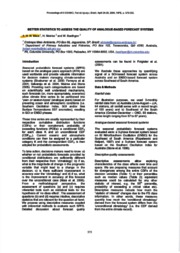Better statistics to assess the quality of analogue-based forecast systems.
Better statistics to assess the quality of analogue-based forecast systems.
Author(s): MAIA, A. de H. N.; MEINKE, H.; BAETHGEN, W.
Summary: Seasonal probabilistic forecast systems (SPFS) based on the analogue years approach (AYA) are used worldwide and provide valuable information for decision makers managing climate-sensitive systems (Sivakumar et al. 2000; Ferreyra et al. 2001; Selvaraju et al. 2004; Meinke and Stone 2005). Providing such categorisations are based on scientifically well understood mechanisms, such forecasts (or, more appropriately, scenarios) allow climate time series to be partitioned into ?year- or season-types? (analogue years) based on prevailing ocean and atmospheric conditions (i.e. Southern Oscillation Index, SOI and/or Sea Surface Temperatures SST anomalies), resulting in SOI or ENSO phases. These time series are usually represented by their respective cumulative distribution functions (CDFs) or their complement, probability of exceeding functions (POEs): a conditional CDFK for each class K and an unconditional CDF (CDFALL). Current oceanic and atmospheric conditions can then be assigned to a particular category K and the correspondent CDFK is then adopted for probabilistic assessments. To take action, decisions makers need to know: a) whether or not probabilistic forecasts provided by conditional distributions are sufficiently different from their respective from `climatology?; b) if so, what is the magnitude of change in the prognostic variable that might lead to a change in the decision; c) is there sufficient improvement in accuracy over the ?climatology? and d) if so, what is the improvement in accuracy of this forecast over the unconditional case (Maia et al. 2006). From a methodological perspective, the assessment of questions (a) and (c) requires inferential tools such as statistical tests for the hypothesis of `no class effect´. The assessment of questions (b) and (d) requires intuitive, descriptive statistics that are relevant for the question at hand. We propose using descriptive measures coupled with inferential methods to evaluate such SPFS. Detailed discussion about forecast qualit yassessments can be found in Potgieter et al. 2004). We illustrate these approaches by quantifying signal of a SOI-based forecast system across Australia and an ENSO-based forecast system across Southeast of South America.
Publication year: 2006
Types of publication: Paper in annals and proceedings
Unit: Embrapa Environment
Keywords: Estatística, Previsão do tempo
Observation
Some of Embrapa's publications are published as ePub files. To read them, use or download one of the following free software options to your computer or mobile device. Android: Google Play Books; IOS: iBooks; Windows and Linux: Calibre.
Access other publications
Access the Agricultural Research Database (BDPA) to consult Embrapa's full library collection and records.
Visit Embrapa Bookstore to purchase books and other publications sold by Embrapa.

